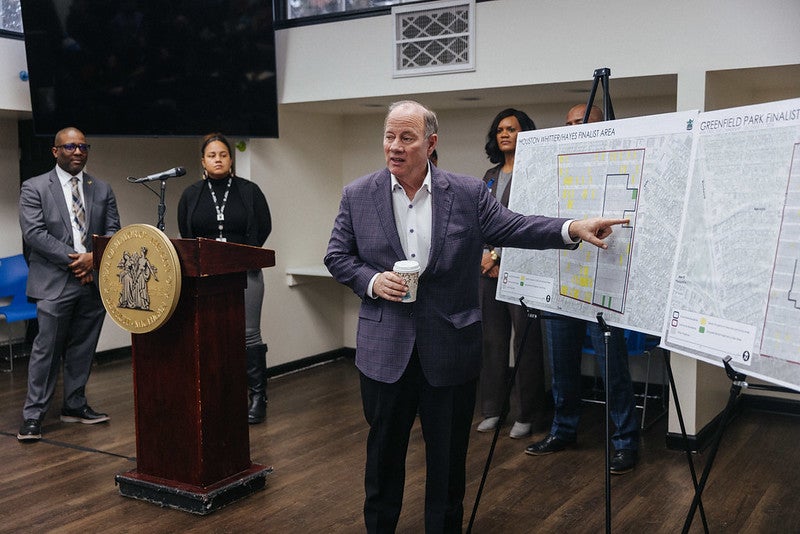Results were released today for California’s second cap-and-trade auction of the year, and the first auction since Governor Newsom proposed extending California’s cap-and-trade program through 2045 as part of his May budget proposal. As California lawmakers consider the future of the cap-and-trade program, they face a pivotal opportunity to deliver real and lasting benefits to communities across the state. At stake is not only California’s continued leadership on climate, but also the potential to unlock major economic and affordability gains for Californians.
Climate 411
Despite lower revenue due to program uncertainty, a stronger, long-term Cap and Trade promises to strengthen investments in California
Detroit Showcases How Clean Energy and Community Benefits Go Hand-in-Hand
Written Q&A with Tepfirah Rushdan, Director of the Detroit Office of Sustainability, on the city’s solar neighborhoods project.

Mayor Mike Duggan and other city officials share information about the selected solar neighborhoods with community members during a January 2025 press conference.
Detroit is modeling how to co-create clean energy solutions with communities by combining urban revitalization efforts with sustainability goals. The Motor City’s climate goals are ambitious: by 2034, Detroit aims to power 100% of its municipal buildings with clean energy and source 50% of its electricity from clean sources in the next three years. Along the way, the city is advancing a range of co-benefits, including improved public health, more energy efficiency and affordability, and quality jobs and opportunities.
As part of this strategy, Detroit‘s Office of Sustainability and Department of Neighborhoods are teaming up to implement the city’s Neighborhood Solar Initiative, which will build solar arrays on vacant land surrounded by communities that benefit from the repurposed space. Five neighborhoods were selected based on resident interest, and a total of 167 acres of land are being fitted with solar fields, raised gardening beds and other landscaping enhancements. Spearheaded by Mayor Mike Duggan and informed by input from thousands of Detroiters, the effort is one of the first steps to achieving the city’s larger climate goals. By providing clean energy and engaging residents and local nonprofits, Solar Neighborhoods will make new use of vacant areas and offer money-saving energy efficiency upgrades for surrounding homes.
I spoke with Tepfirah Rushdan, Detroit’s Director of Sustainability, to learn more about the city’s Solar Neighborhoods, how communities have been involved during every step of the process and her advice for other local leaders looking to build more sustainable futures for their cities. Read More
As California moves closer to authorizing a West-wide electricity market, new analysis shows how the market will benefit other Western states
This is the second in a blog series on the opportunities presented by the Pathways Initiative. Check back for additional publications in the series coming soon.
An expanded regional electricity market is coming into focus in the West. A bill is currently moving through the California legislature that will enable the state to join a West-wide electricity market operated by a regional organization and overseen by an independent governing board — a move that will unleash California’s clean electricity potential and benefit the entire West. New analysis underscores how this market will deliver cleaner, cheaper and more reliable electricity to its participants.
Despite $1 billion budgeted for clean energy, New York’s delayed cap-and-invest rollout is costing residents billions more in savings
Last week, New York approved its 2025 budget, which includes $1 billion to invest in clean energy, energy efficiency and other programs that will reduce pollution and save New Yorkers money. Unfortunately, the benefits of these investments are overshadowed by the delayed launch of New York’s cap-and-invest program, which would provide billions more in savings to New Yorkers every year.
As the California legislature looks to reauthorize cap-and-trade, they cannot forget the strongest climate safeguard the state has: the cap itself
In the face of federal attacks on U.S. climate progress, Governor Newsom recently announced that California was “doubling down on cap-and-trade: one of our most effective tools to cut emissions and create good-paying jobs.” And at the heart of that program is the emissions cap: the firm, declining limit on climate pollution that drives progress on emissions reductions across the state.
With the cap-and-trade program up for reauthorization this year and the California Air Resources Board (CARB) evaluating important program updates, now is a crucial moment to revisit what matters most: the cap.
What is the cap and why does it matter?
The cap is the foundation of California’s cap-and-trade program. It sets a binding, declining limit on greenhouse gas emissions from the state’s largest polluters, covering roughly 75% of statewide climate pollution. Each year, California issues a declining number of emissions allowances — each one representing one ton of carbon pollution — and the amount issued is limited to the total allowed under the state’s emissions cap. The allowances are either auctioned at quarterly auctions, or distributed to regulated entities to benefit ratepayers and insulate them from price impacts. Because the total number of allowances declines each year, overall emissions must also fall. The cap is what gives the cap-and-trade program its climate power. The built-in trajectory that the cap represents ensures steady, predictable progress toward California’s climate goals — as long as the cap is properly calibrated to achieve those goals.
California’s emissions cap is designed to help achieve both near- and long-term climate targets. Under the state’s 2022 Scoping Plan, California is aiming to cut emissions 48% below 1990 levels by 2030, and at least 85% below 1990 levels by 2045. Hitting those targets requires consistent and meaningful progress. The design of the cap, and especially how quickly it declines, plays a key role in determining how much pollution is avoided in this critical decade. These cumulative emissions are incredibly important: every ton of pollution we avoid emitting today reduces the long-term buildup of pollution in the atmosphere, limiting warming and the damage of future climate impacts.
Cap-and-trade is part of a broad suite of climate policies in California, including clean air standards, electrification efforts, and clean fuels. But while most policies are designed to incentivize reductions or reduce emissions from specific sectors or sources, the cap ensures that economy-wide emissions stay within the limit of the cap. That makes the cap a critical ‘insurance policy’ — even if other programs don’t deliver the level of emissions reductions they expected, the cap guarantees an upper bound on pollution.
How can the cap be strengthened?
Lawmakers have the opportunity this year to reaffirm their commitment to ambitious, effective climate action by extending the cap-and-trade program. The cap is what guarantees that emissions go down, and reauthorization should reinforce that core principle.
At the same time, CARB is evaluating near-term changes to the program through a rulemaking process. One of the most important choices on the table is how the cap will be structured until 2030. Encouragingly, CARB is considering options that would properly align the cap with emission reductions the 2022 Scoping Plan says are necessary. With reauthorization, lawmakers can ensure that this cornerstone program can keep delivering emissions reductions for Californians while generating billions of dollars in investments for climate resilience, environmental justice priorities and to help address affordability. Also, with the current rulemaking, CARB has the chance to make sure that these reductions are swift enough to avoid the worst impacts of climate change.
These are both necessary and crucial steps — strengthening the cap through long-term reauthorization and the rulemaking will keep California on track for near-term climate success, and create a model for other states to follow. Because — when it comes to California’s climate future — it’s about the cap.
An Executive Order is attempting to interfere with ironclad state authority to protect people from pollution
States have broad and bedrock authority to protect people from pollution – and President Trump’s Executive Order issued yesterday instructing the Attorney General of the United States to interfere with foundational state prerogatives to protect people from harm cannot change that.
The Executive Order was one of four the President signed yesterday. It is revealing that this order attacking state action came in tandem with another Executive Order that showcased his efforts, certain to fail, to force the American people to use expensive and high-polluting coal. That coal order would make President Trump squarely responsible for imposing a massive tax on the American people in the form of higher energy prices, as it is well established that coal power is costly before even factoring in its roles in contributing to deadly soot and smog and in fueling the deadly fires, heat waves, and storms caused by climate change.














